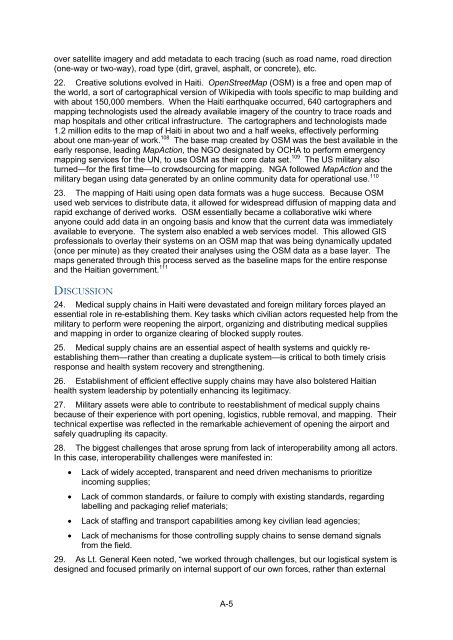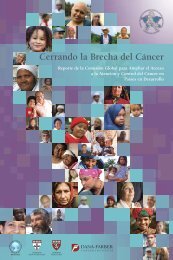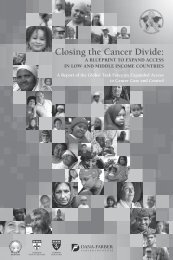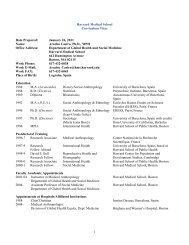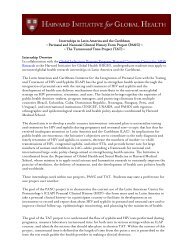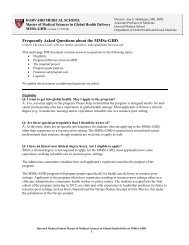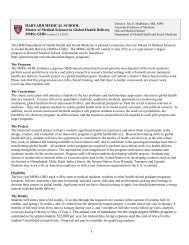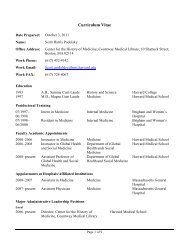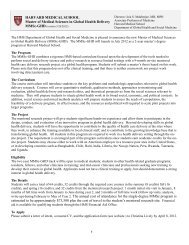Haiti Case Study - The Department of Global Health and Social ...
Haiti Case Study - The Department of Global Health and Social ...
Haiti Case Study - The Department of Global Health and Social ...
Create successful ePaper yourself
Turn your PDF publications into a flip-book with our unique Google optimized e-Paper software.
over satellite imagery <strong>and</strong> add metadata to each tracing (such as road name, road direction<br />
(one-way or two-way), road type (dirt, gravel, asphalt, or concrete), etc.<br />
22. Creative solutions evolved in <strong>Haiti</strong>. OpenStreetMap (OSM) is a free <strong>and</strong> open map <strong>of</strong><br />
the world, a sort <strong>of</strong> cartographical version <strong>of</strong> Wikipedia with tools specific to map building <strong>and</strong><br />
with about 150,000 members. When the <strong>Haiti</strong> earthquake occurred, 640 cartographers <strong>and</strong><br />
mapping technologists used the already available imagery <strong>of</strong> the country to trace roads <strong>and</strong><br />
map hospitals <strong>and</strong> other critical infrastructure. <strong>The</strong> cartographers <strong>and</strong> technologists made<br />
1.2 million edits to the map <strong>of</strong> <strong>Haiti</strong> in about two <strong>and</strong> a half weeks, effectively performing<br />
about one man-year <strong>of</strong> work. 108 <strong>The</strong> base map created by OSM was the best available in the<br />
early response, leading MapAction, the NGO designated by OCHA to perform emergency<br />
mapping services for the UN, to use OSM as their core data set. 109 <strong>The</strong> US military also<br />
turned—for the first time—to crowdsourcing for mapping. NGA followed MapAction <strong>and</strong> the<br />
military began using data generated by an online community data for operational use. 110<br />
23. <strong>The</strong> mapping <strong>of</strong> <strong>Haiti</strong> using open data formats was a huge success. Because OSM<br />
used web services to distribute data, it allowed for widespread diffusion <strong>of</strong> mapping data <strong>and</strong><br />
rapid exchange <strong>of</strong> derived works. OSM essentially became a collaborative wiki where<br />
anyone could add data in an ongoing basis <strong>and</strong> know that the current data was immediately<br />
available to everyone. <strong>The</strong> system also enabled a web services model. This allowed GIS<br />
pr<strong>of</strong>essionals to overlay their systems on an OSM map that was being dynamically updated<br />
(once per minute) as they created their analyses using the OSM data as a base layer. <strong>The</strong><br />
maps generated through this process served as the baseline maps for the entire response<br />
<strong>and</strong> the <strong>Haiti</strong>an government. 111<br />
DISCUSSION<br />
24. Medical supply chains in <strong>Haiti</strong> were devastated <strong>and</strong> foreign military forces played an<br />
essential role in re-establishing them. Key tasks which civilian actors requested help from the<br />
military to perform were reopening the airport, organizing <strong>and</strong> distributing medical supplies<br />
<strong>and</strong> mapping in order to organize clearing <strong>of</strong> blocked supply routes.<br />
25. Medical supply chains are an essential aspect <strong>of</strong> health systems <strong>and</strong> quickly reestablishing<br />
them—rather than creating a duplicate system—is critical to both timely crisis<br />
response <strong>and</strong> health system recovery <strong>and</strong> strengthening.<br />
26. Establishment <strong>of</strong> efficient effective supply chains may have also bolstered <strong>Haiti</strong>an<br />
health system leadership by potentially enhancing its legitimacy.<br />
27. Military assets were able to contribute to reestablishment <strong>of</strong> medical supply chains<br />
because <strong>of</strong> their experience with port opening, logistics, rubble removal, <strong>and</strong> mapping. <strong>The</strong>ir<br />
technical expertise was reflected in the remarkable achievement <strong>of</strong> opening the airport <strong>and</strong><br />
safely quadrupling its capacity.<br />
28. <strong>The</strong> biggest challenges that arose sprung from lack <strong>of</strong> interoperability among all actors.<br />
In this case, interoperability challenges were manifested in:<br />
• Lack <strong>of</strong> widely accepted, transparent <strong>and</strong> need driven mechanisms to prioritize<br />
incoming supplies;<br />
• Lack <strong>of</strong> common st<strong>and</strong>ards, or failure to comply with existing st<strong>and</strong>ards, regarding<br />
labelling <strong>and</strong> packaging relief materials;<br />
• Lack <strong>of</strong> staffing <strong>and</strong> transport capabilities among key civilian lead agencies;<br />
• Lack <strong>of</strong> mechanisms for those controlling supply chains to sense dem<strong>and</strong> signals<br />
from the field.<br />
29. As Lt. General Keen noted, “we worked through challenges, but our logistical system is<br />
designed <strong>and</strong> focused primarily on internal support <strong>of</strong> our own forces, rather than external<br />
A-5


